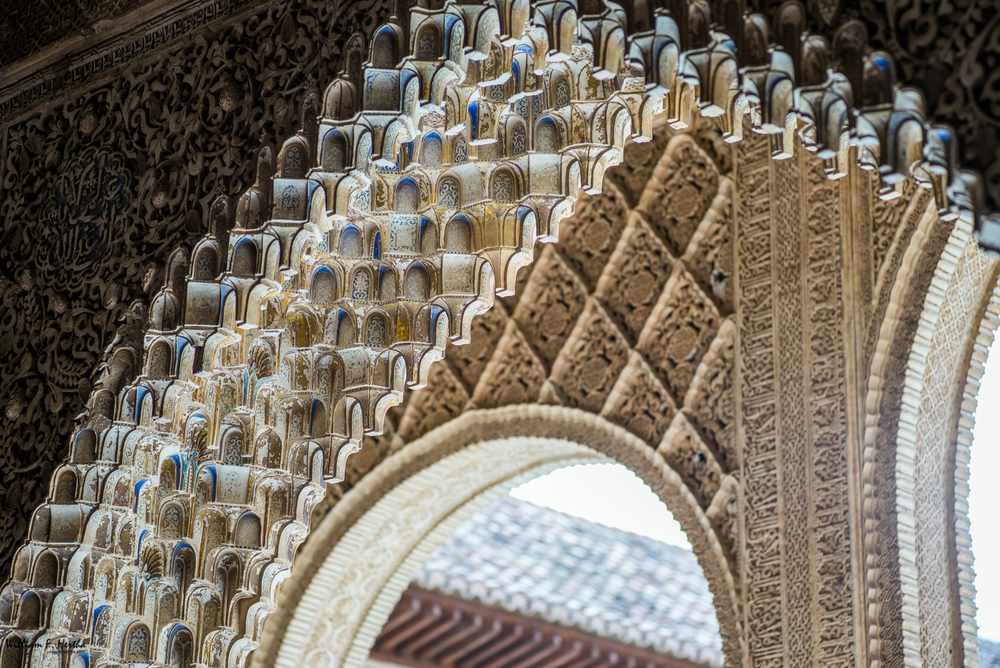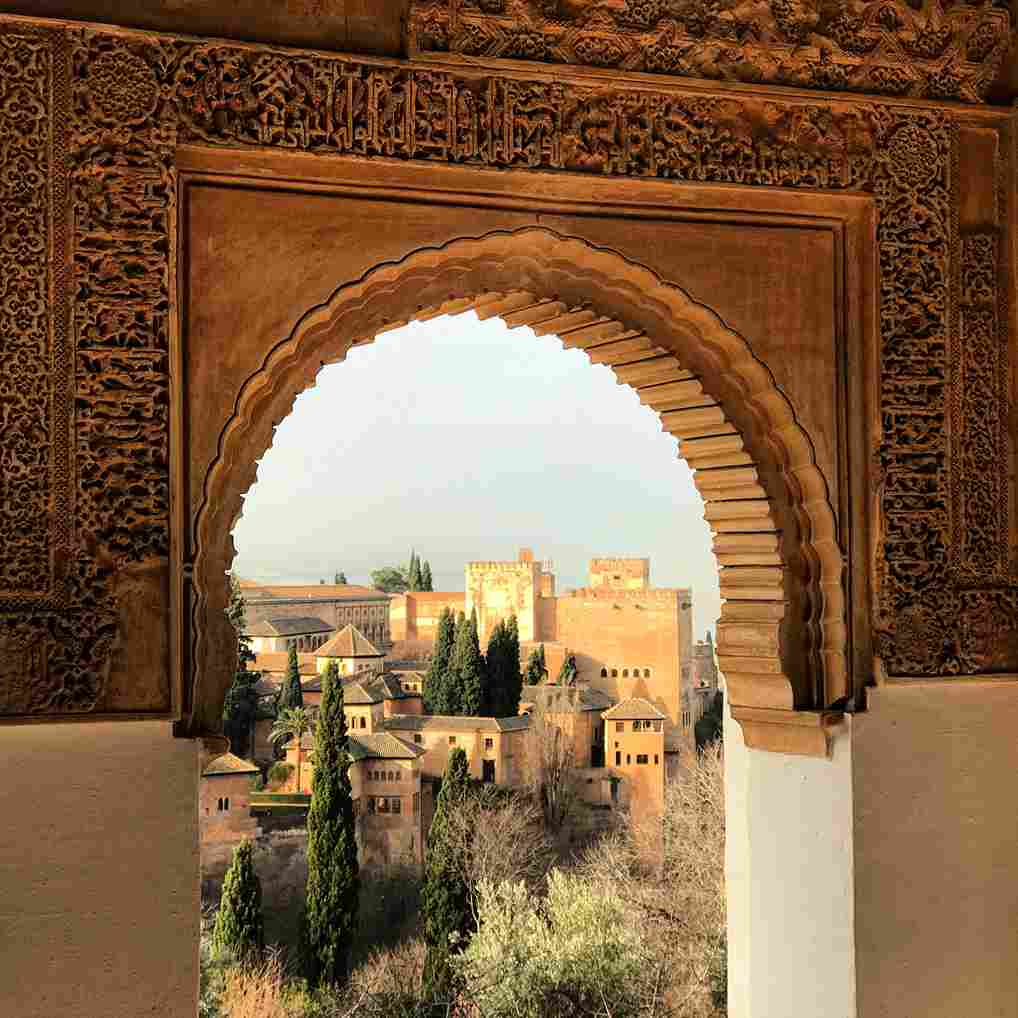For almost 8 centuries, Muslims occupied Spain. From 711 to 1492, the Arab culture has left its mark through dance, food, and Islamic architecture. They constructed palaces for the monarchy, mosques for caliphs, and castles for people. The UNESCO recognized their expertise and tourists rush to visit Arabic monuments in Spain every year.

What kind of Islamic architectural patterns exists in Spain?
First, Islamic architecture stands out from Christian and Judaism monuments. Indeed, Moorish art doesn’t directly represent religious icons or human beings. While representations of the divine are encouraged in other monotheistic religions, the Quran doesn’t allow explicit devotions. This makes theological symbols fade away in favor of unique architectonic patterns.
There are 3 key elements of Islamic architecture in Spain.
Geometry, botany, and calligraphy

Arabic architecture in Spain distinguishes itself from the other form of art by its complexity. On several walls and ceilings, geometrical vegetal forms are repeated indefinitely to form arabesque patterns.
Furthermore, calligraphy is an important part of Moorish art. It combines architecture with poetry. A long time ago, artists drew short poems directly on architecture. Because of Quran’s prohibition to represent religious icons, the message of Islam was transmitted through a written script. So, calligraphy was painted on the walls to narrate the Islamic faith. Words upgraded images. Still, calligraphies are colorful and aesthetic.
These patterns are visible within several Spanish monuments. Together, they represent Arabic architecture in all its intricate beauty. Their main declinations can be found throughout the country.
Islamic architecture in Spain: design
Arabic architecture is an integral part of Moorish art, meanly thanks to the craft techniques developed over the years.
Muqarnas

They are also called, « honeycomb ceiling » or “stalactite vaulting”. Muqamas will be located in important areas like central halls. This pattern offers soft transitions between different spaces. They are visible on ceilings, and arches and can hide the structural foundations that bear a dome. Furthermore, they represent the universal creation by God.
Carved plaster

Carved plaster, also called “yesería” usually decorate upper walls in Islamic architecture in Spain.
Tiles decoration

Tiles started to appear in most courtyards and interiors in the late Middle Ages. But even today, Spanish modern architects use it to embellish their buildings.
Artesonado ceilings

Artesonado ceilings are composed of intricated pieces of wood. You would lose track of time, amazed by this piece of work. It’s thousands and thousands of small carved wood shaping into infinite geometric patterns. You can see several of them in the Alhambra Palace in Spain.
1. The Alhambra Palace in Granada


This monument attracts millions of people each year. And for a good reason: it’s one of the best Islamic architecture in Spain. Alhambra, in Arab Al-Hamrā, means « the red one » due to the colors of its walls. It’s a palace-city, which housed 6 palaces. But today, only 4 of the 6 of them survived.
Muslims created this monument in the perfect spot. Indeed, the nearby Sierra Nevada mountain offered water for the construction. Also, it was located next to Malaga and Almerià ports, the Mediterranean coastline for commerce trades.
The Alhambra Palace in Granada was built and rebuilt piece by piece. During the 8 centuries of occupation, several Muslim high profiles like Muhammed I, II, then Muhammed V, brought their knowledge to the construction of the palace. They have contributed to making this monument a symbol of Moorish art. Unfortunately in the 19th century, the red castle was falling apart due to low maintenance. Restorations began during the next century. These multiple refurbishments changed some elements inside the Alhambra Palace of Spain. Indeed, the Patio de Los Leones was first on grass, then on gravel, and now it’s covered by marble.
Because Muslim culture doesn’t allow explicit devotions, the beauty of the Alhambra Palace of Granada is only visible from the inside. What a perfect excuse to visit this Arabic architecture!
The architectonic richness of features. Indeed, the fountain of the Lions is the most photographed spot in the palace. And during your wandering, you can pass by Generalife and El Partal, the quieter spots of the palace.
We recommend you schedule 4 hours of your time to fully enjoy the Alhambra Palace in Spain.
2. Cuarto Real de Santo Domingo in Granada

Located in the Realejo district of Granada, it was first considered a palace. Then, after the Christian’s reconquest, it became a convent.
Like the Alhambra Palace, the beauty of the Cuarto Real de Santa Domingo is revealed inside. This Islamic architecture in Spain is rich in cut tiles, carved plaster, muqarnas, and artesonado ceilings to see in 2 hours visit.
3. Mezquita-Cathedral in Cordoba


Cordoba has several Arabic architectures, but Mezquita-Cathedral is the best one. The construction began in 784 and over the years, the mosque gained in splendor. Abd al-Rahman I erected 130 columns, which was the beginning of a huge column expansion. Indeed, the Mezquita-Cathedral is famous for its forest of columns composed “only” of 856 tall and colorful columns.
Later on, Abd al-Rahman III constructed a minaret for prayers. In addition, Al-Hakam II pulled together a library of more than 40.000 volumes and raised a mihrab inside of the mosque. The mihrab is famous for its intersecting cusped arches. This Islamic architecture type is unique in Spain. Finally, after the reconquest, the monument became a famous church for Christian prayers.
You can admire this mosque revisited into a church in a 2 hours visit.
4. The Alcázar in Sevilla


Built-in the 11th century, the Alcázar is the oldest Islamic palace in Spain. However, UNESCO recognized its beauty and its complexity, and it’s now a World Heritage Site. Like the other Islamic architecture in Spain already presented, the Alcázar had been occupied by many monarchs that governed this city, who modified it to their tastes as well.
In the 12th century, Muslims created the Patio del Yeso inside the Alcázar. The courtyard is beautiful, with a pool reflecting the sky in the middle. This disposition isn’t new in Arabic architecture. Indeed, creating aquatic monuments was a common practice. It allows them to easily have access to reliable sources of hydration. In addition, water is an Islamic symbol of life and purity, especially when it’s in the gardens. It represents the sacred lake in paradise, reserved only for the right people.
The Alcázar in Sevilla houses several Islamic patterns, others than the one presented in this article. Inside the monument, you can admire arches, doors, and windows shaped like horseshoes and so on.
Finally, the gardens of Alcázar had functional purposes. Indeed, the plants within the gardens fed court members. But most of all, these installations stay famous for their aesthetic. To create the gardens from scratch, Muslims took inspiration from paradise as described in the Quran.
2 hours is necessary to visit this piece of Moorish art.
5. La Giralda in Sevilla

La Giralda in Sevilla is one of the UNESCO World Heritage Sites. Built as a Minaret, it’s now the bell tower of Sevilla’s cathedral. The tower is from medieval Spain and is located next to the cathedral. It took 73 years for the Muslims to finish it and today it rises up to 104 meters. You can walk through a spiral ramp to reach the top of the tower.
6. The Medina Azahara


Contemporary sources described the Medina Azahara as a unique piece of Islamic architecture in Spain. It was a “shining city”, and its beauty stayed but its functional aspect disappeared. Covering more than 112 hectares, this vanished city included baths, markets, and mosques. The complex housed three levels, protected by a double wall. A palace and the caliph’s rooms fulfilled the highest floor. The courtiers and their associates occupied the second level. Finally, the last level was for the gardens and orchards.
The Medina Azahara is located on a hill, in the west of Cordoba. 3 hours is necessary to visit this Arabic architecture complex.
7. The Aljaferià in Zaragoza

The Aljaferià in Zaragoza was the Taifal palace of Al-Muqtádir. It’s the last memory of the Taifa period in Spain. The historic era symbolized the split of Andalusia into several kingdoms, due to Muslim divisions and tensions. It’s a UNESCO World Heritage Site, representing one of the finest Islamic architecture in Spain. First, you can admire the Golden Hall of the palace. This place hides geometric patterns, like an Artesonado ceiling showing the stars of the cosmos or beautiful arches and pillars. A small mosque in the palace is also remarkable by its horseshoe arch and its circle of stones. And finally, the Patio de Santa Isabel. This courtyard harmonizes the palace and gathers waterfalls, multifoil arches, and vegetation.
After the reconquest, the Aljaferià in Zaragoza. was modified to best suit Christianity. The palace has extended, to incorporate the church of San Martin.
The visit to this former palace will take 1 hour and a half.
8. The Alcazaba in Malaga

The Alcazaba, meaning “citadel” in Arabic, is an Islamic fortification at the bottom of Mount Gibralfaro. The Muslims built it from the remains of an ancient Roman fortress. During Middle Ages, this castle was never defeated. Indeed, its inhabitants surrendered to their enemies after a long siege, only because of hunger and thirst. Its purpose was to protect the people of Malaga or to host Muslim nobility. But after the 17th century, several earthquakes and successive wars damaged the fortress.
Despite this, tourists appreciate the Alcazaba in Malaga. The multiple arches are one of the marks left of Islamic architecture in Spain. Moreover, the gardens of the fortress offer a unique view of the city.
One hour and a half are necessary to visit the former fortress of Alcazaba in Malaga.
Spain is the home of several outstanding Islamic architectures. It’s the mark of a strong historical period in the country and it still continues to inspire contemporary Spanish architects. In addition, Flamenco is also a UNESCO world heritage.












